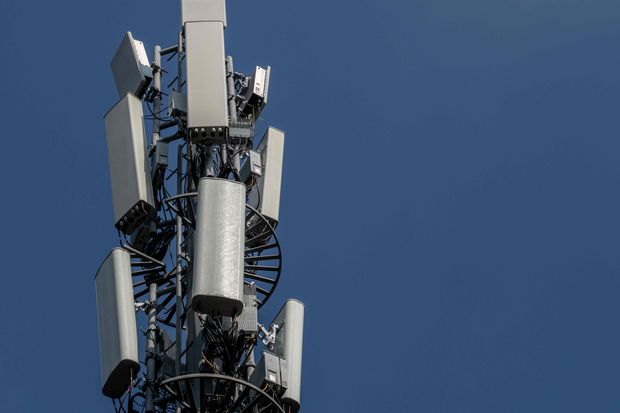
One way to invest in 5G is through the companies that own cellphone towers.
Agence France-Presse/Getty Images
The potential of 5G is already on the radar of investors around the world, with revenue from 5G wireless network infrastructure expected to reach $8.1 billion in 2020. That represents a 96% increase from 2019, according to Gartner, a research firm.
As COVID-19 continues its destructive path, many countries and regions around the world see 5G expansion as a pathway to economic recovery and growth. As a result, governments, private industry and investors are lining up to make the necessary investments to advance the infrastructure needed for 5G.
What was once seen as a longer-term play, 5G is blossoming in a period when it is needed most. So-called “pioneer countries,” including the United States, Japan, South Korea and China have already deployed “the first high-band 5G networks” in select major cities, according to a 2020 McKinsey report. Meanwhile, Apple recently unveiled its inaugural 5G phone lineup.
For these reasons, we believe the time is now to take advantage of this growing yet underappreciated trend. Across its supply chain, 5G is poised to make a significant impact, from the infrastructure powering the network to the equipment and retail service providers evolving their product suites to leverage its enhanced capabilities.
As the momentum around 5G grows, here are several ways investors can take advantage now:
Communications towers
Much of the current investment interest in 5G is centered on cellular communications towers. These macro towers remain the most cost-effective way to deploy wireless spectrum and they are in short supply in many areas.
In the U.S., there are about 150,000 towers, around 95% of which are owned by private operators. In Europe, there are about 350,000 towers and just 20% are privately owned. The number of towers in Europe is expected to grow to 450,000 sites by 2025, according to Morgan Stanley. Many countries, however, are starting with a much lower base. Mexico has just 33,000 while Brazil has only 61,000, according to JP Morgan research estimates.
We believe cell towers are the most attractive pure play to take advantage of 5G. For one, 5G requires more towers to operate effectively, and given the cost and complexity of siting, building and upgrading towers and other infrastructure, the barriers to entry are high. Once that infrastructure is in place, however, operating costs are relatively low, and the towers have a long operational life. We also appreciate the potential resilience of communications infrastructure given its presumed lower correlation and volatility compared with some other asset classes.
Most private cell-tower operators are traded on the stock market, and there are different ways to invest them. If you’re looking for more mature, U.S.-based firms, Crown Castle International CCI, -2.34% and American Tower AMT, -2.55% generate strong dividends and stable growth, with American Tower also providing international exposure.
For a higher growth play, Spain-headquartered Cellnex Telecom CLNX, +0.29% continues to buy and consolidate tower portfolios in Europe, including recent acquisitions in Poland. Cellnex has consistently outperformed the stock market over the past two years, and given the opportunity for privatization in Europe, there’s still room for growth.
Equipment makers
Moving past cell tower companies and further down the supply chain, equipment operators and manufacturers are also poised to take advantage of the 5G boom. Semiconductors will be an integral part of the transition to 5G, and firms such as Broadcom AVGO, -3.44% and Samsung Electronics 005930, -1.52% that create chips for cell phones and other mobile devices stand to benefit as leading players in the space.
In addition to improving mobile and remote capabilities, offices, apartment buildings and public utilities such as airports and mass transit will be built and/or renovated with the latest 5G capabilities. Equipment suppliers such as Nokia NOK, -4.48% NOKIA, -16.37%, which has a strong foothold in the space, should expand its market share.
Consumer plays
Among the largest beneficiaries of the 5G evolution will be the service providers and device manufacturers that power and create the technologies we as consumers use every day. In recent years, consumers have been less motivated to buy the latest phone models because of their high prices and limited advancements, but new models with 5G compatibility will provide companies such as Apple AAPL, -4.63% and Samsung Electronics — two of the world’s largest cell phone manufacturers — ample reason to entice existing customers into upgrading their devices.
At the same time, consumers will be inclined to purchase higher-priced data plans that incorporate 5G. We’re already seeing this trend in Asia, where service providers have increased their average revenue per unit by 30% for high-data 5G plans.
In the U.S., the big three U.S. providers — Verizon VZ, -1.86%, T-Mobile TMUS, -2.67% and AT&T T, -1.56% — are racing to secure the fastest and most reliable networks.
We think T-Mobile is the most attractively valued and in the best position to gain market share. Following its merger with Sprint, T-Mobile has a vast wireless spectrum and is poised to have a strong 5G network.
Now read: Here are five stocks to own for the 5G network buildout
Josh Duitz is a senior portfolio manager at Aberdeen Standard Investments and the co-manager of the Aberdeen Standard Global Infrastructure Income Fund ASGI, -2.18%. Across his funds, he holds shares in Apple, Crown Castle International, Cellnex Telecom, American Tower, Broadcom, Samsung Electronics, Nokia and T-Mobile.










Add Comment